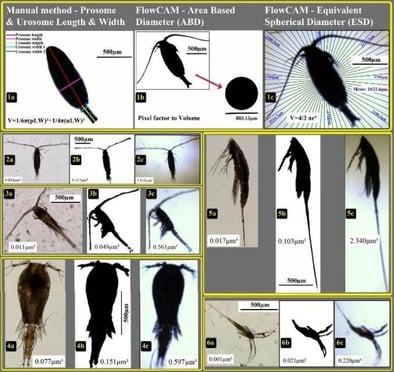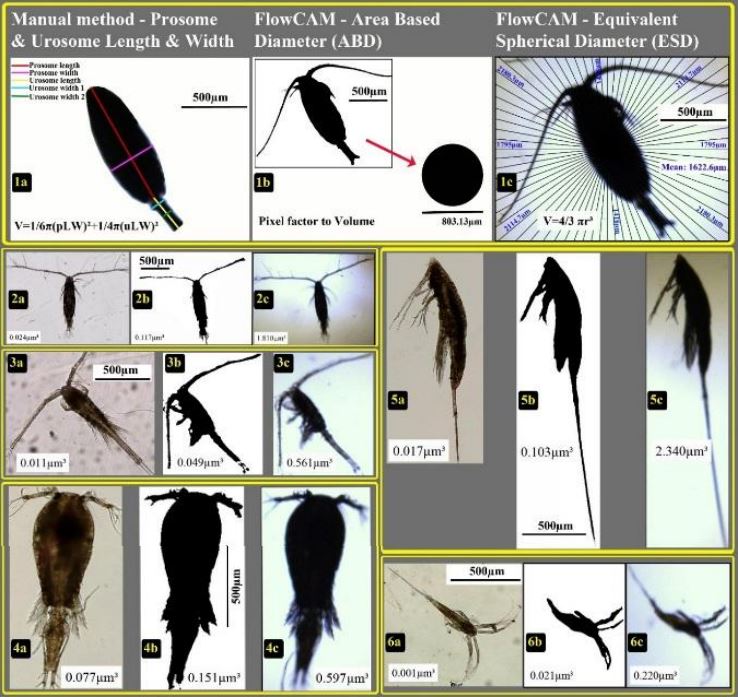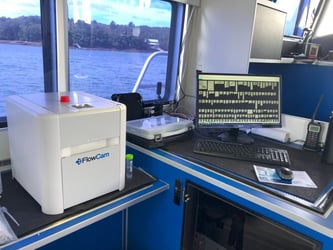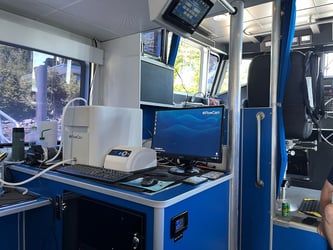Aquatic researchers have long relied upon monitoring zooplankton to understand the trophic status and ecological response of an aquatic system. Copepods, the most abundant taxonomic group of zooplankton, play a vital role in linking primary producers with higher level consumers. The FlowCam has become a favored substitute to manual microscopy when researchers are looking to rapidly quantify plankton communities and estimate their biovolume.
A Comparison of Biovolume Estimations

Pictured here: Biovolume estimations of various copepods using traditional microscopy (a), FlowCam ABD algorithm (b), and FlowCam ESD algorithm (c). Image from Karnan et al. (2017).
In the article, "On the Accuracy of assessing copepod size and biovolume using FlowCam and traditional microscopy", published in the Journal of Geo Marine Sciences, Karnan et al. (2017) compare the FlowCam's ability to estimate length and biovolume to that of a traditional microscope. Microscopy is considered to be the most accurate and globally accepted method to measure size and biovolume of individual copepods. However, protruding body parts (i.e. appendages, cilia, etc.) are not easily accounted for in biovolume estimations using traditional microscopy and often result in inaccurate estimations.
The FlowCam, a flow imaging microscope, provides digital images of each particle, or in this case copepod, and provides 40+ morphological measurements. For an Area Based Diameter (ABD) calculation, the diameter measured by the number of grey scale pixels of the binary image of copepods is converted to a circle with the same number of pixels. Total biovolume of the individual organism is generated from the pixel volume of the image.
ESD Method vs. Traditional Microscopy
For an Equivalent Spherical Diameter (ESD) algorithm, the mean of 36 diameter values measured at every 5 degree angle of the specimen is considered to estimate biovolume. This algorithm is accurate only when the specimens have a spherical or elliptical shape with short or no extended appendages. If the organism is not spherical and has extended appendages, it was found that FlowCam ESD-based biovolume overestimates due to the incorporation of appendages, and traditional microscopy underestimates due to the omission of appendages.
ABD Method vs. Traditional Microscopy
The FlowCam's ABD algorithm selects only the darkened region of the image to generate the biovolume and, in all cases, was found more accurate than ESD-based biovolume and biovolume calculated by traditional microscopy. The ABD algorithm of FlowCam provides a better estimation of copepod biovolume compared to traditional microscopy, as this method also incorporates the appendages and other extruded portions of the copepod for biovolume estimation. ABD biovolume was found to be greater than biovolumes calculated using traditional microscopy due to the contribution of appendages and other extended body parts.
Learn More
Read the entire paper here: On the accuracy of assessing copepod size and biovolume using FlowCam and traditional microscopy.
Reference:
Karnan, C., Jyothibabu, R., Manoj Kumar, T.M., Jagadeesan, L., Arunpandi, N. (2017) On the accuracy of assessing copepod size and biovolume using FlowCam and traditional microscopy. Journal of Geo Marine Sciences. Vol 46 (07), pp. 1261-1264.












